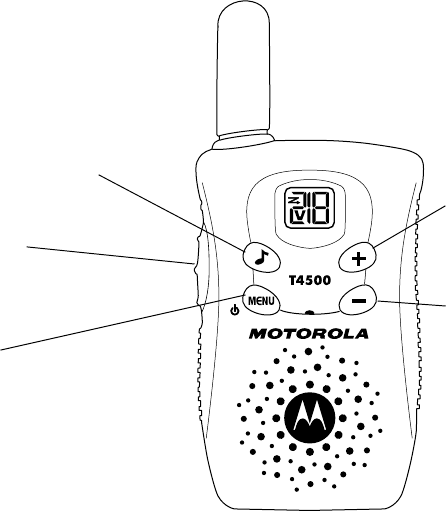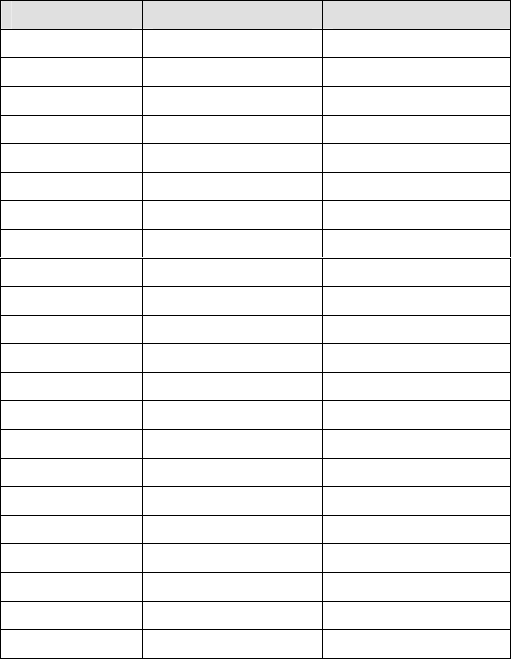Giant Electronics T4500 Transmitter Portion of FRS & GMRS User Manual Charon
Giant Electronics Ltd Transmitter Portion of FRS & GMRS Charon
Contents
- 1. Users Manual
- 2. Product literature
Users Manual
PRELIMINARY
T4500 Series Two-Way Radio User Guide
PRELIMINARY
November 12, 2002
2
PRELIMINARY
Congratulations on your purchase of a Motorola Product!
Product registration is an important step toward enjoying your new Motorola product. Registering helps us facilitate warranty
service, and permits us to contact you should your Motorola product require an update of other service. Registration is not required
for warranty coverage.
To register your product on-line, visit
www.motorola.com/warranty/radios
.
Please retain your original dated sales receipt for your records. For warranty service of your Motorola product, you will need to
provide a copy of your dated sales receipt to confirm warranty status.
For a copy of a large-print version of this guide, or for product-related questions, call:
1-800-353-2729 in the USA
1-888-390-6456 TTY (Text Telephone)
On the web, visit our website at
www.motorola.com/store
.
Motorola, the Stylized M Logo, and all other trademarks indicated as such herein are trademarks of Motorola, Inc.
Reg. U.S. Pat. & Tm. Off.
© 2002 Motorola, Inc. All rights reserved.
Motorola Personal Communications Sector
Consumer Products Division
1705 Belle Meade Court
Lawrenceville, GA 30043

Safety and General Information
1
SAFETY AND GENERAL INFORMATION
IMPORTANT INFORMATION ON SAFE AND EFFICIENT OPERATION
READ THIS INFORMATION BEFORE USING YOUR RADIO
The information provided in this document supersedes the general safety
information contained in user guides published prior to July 2000.
This device complies with Part 15 of the FCC Rules. Operation is subject to the
following two conditions: (1) this device may not cause harmful interference, and (2)
this device must accept any interference received, including interference that may
cause undesired operation.
Transmit and Receive Procedure
Your two-way radio contains a transmitter and a receiver. To transmit (talk), you must
push the Talk button; to receive (listen), release the Talk button.
Exposure To Radio Frequency Energy
Your Motorola radio is designed to comply with the following national and
international standards and guidelines regarding exposure of human beings to radio
frequency electromagnetic energy:
• United States Federal Communications Commission, Code of Federal
Regulations; 47 CFR part 2 sub-part J
6881040B40a.book Page 1 Friday, July 12, 2002 11:46 AM

Safety and General Information
2
• American National Standards Institute (ANSI) / Institute of Electrical and
Electronic Engineers (IEEE) C95. 1-1992
• Institute of Electrical and Electronic Engineers (IEEE) C95.1-1999 Edition
• International Commission on Non-Ionizing Radiation Protection
(ICNIRP) 1998
• Ministry of Health (Canada) Safety Code 6. Limits of Human Exposure to
Radiofrequency Electromagnetic Fields in the Frequency Range from 3 kHz
to 300 GHz, 1999
• Australian Communications Authority Radiocommunications
(Electromagnetic Radiation - Human Exposure) Standard 2001 (applicable
to wireless phones only)
• ANATEL, Brasil Regulatory Authority, Resolution 256 (April 11, 2001)
“additional requirements for SMR, cellular and PCS product certification.”
To assure optimal radio performance and make sure human exposure to radio
frequency electromagnetic energy is within the guidelines set forth in the above
standards, always adhere to the following procedures:
PORTABLE RADIO OPERATION AND EME EXPOSURE
Antenna Care
Use only the supplied or an approved replacement antenna. Unauthorized
antennas, modifications, or attachments could damage the radio and may violate
FCC regulations.
6881040B40a.book Page 2 Friday, July 12, 2002 11:46 AM

Safety and General Information
3
DO NOT hold the antenna when the radio is “IN USE.” Holding the antenna
affects call quality and may cause the radio to operate at a higher power level than
needed.
Two-way Radio Operation
When using your radio as a traditional two-way radio, hold the radio in a
vertical position with the microphone one to two inches (2.5 to 5 cm) away
from the lips.
Body-worn Operation
To maintain compliance with FCC/Health Canada RF exposure guidelines, if you
wear a radio on your body when transmitting, always place the radio in a Motorola
supplied or approved clip, holder, holster, case, or body harness for this product.
Use of non-Motorola-approved accessories may exceed FCC/Health Canada RF
exposure guidelines. If you do not use one of the Motorola-supplied or approved
body-worn accessories, and are not using the radio held in the normal use position,
ensure the radio and its antenna are at least one inch (2.5 cm) away from your
body when transmitting.
To control your exposure and ensure compliance with the general population/
uncontrolled environment exposure limits, always adhere to the following procedure:
• Transmit no more than 50% of the time.
• To transmit (talk), push the Talk button.
• To receive calls, release the Talk button.
6881040B40a.book Page 3 Friday, July 12, 2002 11:46 AM

Safety and General Information
4
Transmitting 50% of the time, or less, is important because the radio generates
measurable RF energy exposure only when transmitting (in terms of measuring
standards compliance).
Data Operation
If applicable, when using any data feature of the radio, with or without an accessory
cable, position the radio and its antenna at least one inch (2.5 cm) away from
the body.
Approved Accessories
For a list of approved Motorola accessories visit our website at www.mot.com.
ELECTROMAGNETIC INTERFERENCE/COMPATIBILITY
Note: Nearly every electronic device is susceptible to electromagnetic interference
(EMI) if inadequately shielded, designed or otherwise configured for
electromagnetic compatibility.
• FACILITIES
To avoid electromagnetic interference and/or compatibility conflicts, turn off your
radio in any facility where posted notices instruct you to do so. Hospitals or
health care facilities may be using equipment that is sensitive to external RF
energy.
• AIRCRAFT
When instructed to do so, turn off your radio when on board an aircraft. Any use
of a radio must be in accordance with applicable regulations per airline crew
instructions.
6881040B40a.book Page 4 Friday, July 12, 2002 11:46 AM

Safety and General Information
5
• MEDICAL DEVICES
Pacemakers
The Advanced Medical Technology Association recommends that a minimum
separation of 6 inches (15 centimeters) be maintained between a handheld
wireless radio and a pacemaker. These recommendations are consistent with
the independent research by, and recommendations of, the United States Food
and Drug Administration.
Persons with pacemakers should:
• ALWAYS keep the radio more than six inches (15 centimeters) from their
pacemaker when the radio is turned ON.
• not carry the radio in the breast pocket.
• use the ear opposite the pacemaker to minimize the potential for
interference.
• turn the radio OFF immediately if you have any reason to suspect that
interference is taking place.
Hearing Aids
Some digital wireless radios may interfere with some hearing aids. In the event
of such interference, you may want to consult your hearing aid manufacturer to
discuss alternatives.
Other Medical Devices
If you use any other personal medical device, consult the manufacturer of your
device to determine if it is adequately shielded from RF energy. Your physician
may be able to assist you in obtaining this information.
6881040B40a.book Page 5 Friday, July 12, 2002 11:46 AM

Safety and General Information
6
Safety and General Use While Driving
Check the laws and regulations on the use of radio in the area where you drive.
Always obey them.
When using your radio while driving, please:
• Give full attention to driving and to the road.
• Use hands-free operation, if available.
• Pull off the road and park before making or answering a call if driving
conditions so require.
OPERATIONAL WARNINGS
• FOR VEHICLES WITH AN AIR BAG
Do not place a portable radio in the area over an air bag or in the air bag
deployment area. Air bags inflate with great force. If a portable radio is placed in
the air bag deployment area and the air bag inflates, the radio may be propelled
with great force and cause serious injury to occupants of the vehicle.
• POTENTIALLY EXPLOSIVE ATMOSPHERES
Turn off your radio prior to entering any area with a potentially explosive
atmosphere, unless it is a radio type especially qualified for use in such areas as
“Intrinsically Safe.” Do not remove, install, or charge batteries in such areas.
Sparks in a potentially explosive atmosphere can cause an explosion or fire
resulting in bodily injury or even death.
Note: The areas with potentially explosive atmospheres referred to above include
fueling areas such as below decks on boats, fuel or chemical transfer or
6881040B40a.book Page 6 Friday, July 12, 2002 11:46 AM

Safety and General Information
7
storage facilities, areas where the air contains chemicals or particles, such
as grain, dust or metal powders, and any other area where you would
normally be advised to turn off your vehicle engine. Areas with potentially
explosive atmospheres are often but not always posted.
BLASTING CAPS AND AREAS
To avoid possible interference with blasting operations, turn off your radio when
you are near electrical blasting caps, in a blasting area, or in areas posted: “Turn
off two-way radio.” Obey all signs and instructions.
OPERATIONAL CAUTIONS
• ANTENNAS
Do not use any portable radio that has a damaged antenna. If a damaged
antenna comes into contact with your skin, a minor burn can result.
•BATTERIES
All batteries can cause property damage and/or bodily injury such as burns if a
conductive material such as jewelry, keys, or beaded chains touch exposed
terminals. The conductive material may complete an electrical circuit (short
circuit) and become quite hot. Exercise care in handling any charged battery,
particularly when placing it inside a pocket, purse, or other container with metal
objects.
6881040B40a.book Page 7 Friday, July 12, 2002 11:46 AM

5
PRELIMINARY
Finding the Controls
Installing the Batteries
Your radio uses 3 AAA Alkaline batteries.
1. Turn the radio off.
2. Remove the battery cover using a coin.
3. Insert batteries so the + marking on each battery matches the one in the compartment.
4. Replace the battery cover.
Change the batteries when (what low battery indicators does the radio have?)
Turning Your Radio On and Off
Press the power button (until you see/hear what?).
Adjusting the Volume
Press <uparrow> to increase the volume and <downarrow> to decease the volume.
Setting the Channel
The channel is the radio frequency wave your radio uses to transmit. Your radio has 22 channels. To change the channel:
1. Briefly press and release <power>.
2. Press <uparrow> or <downarrow> to select a channel.
3. Press <power> to save the new channel setting.
Talking and Listening
To talk, press and hold the Push to Talk button M.
When you are finished talking, release M.
For maximum clarity, hold the radio 2 to 3 inches away from your mouth and speak directly into the microphone. Be careful not to
cover the microphone while transmitting.
Power button:
Long press turns radio on/off.
Short press enters menu to
change channel
Increase volume.
When in menu mode,
change channel.
Decrease volume.
When in menu mode,
change channel.
Call tone (send call tone)
Push to talk,
release to listen

CHANNEL FREQUENCY DESCRIPTION
1 462.5625 MHz FRS / GMRS
2 462.5875 MHz FRS / GMRS
3 462.6125 MHz FRS / GMRS
4 462.6375 MHz FRS / GMRS
5 462.6625 MHz FRS / GMRS
6 462.6875 MHz FRS / GMRS
7 462.7125 MHz FRS / GMRS
8 467.5625 MHz FRS
9 467.5875 MHz FRS
10 467.6125 MHz FRS
11 467.6375 MHz FRS
12 467.6625 MHz FRS
13 467.6875 MHz FRS
14 467.7125 MHz FRS
15 462.5500 MHz GMRS
16 462.5750 MHz GMRS
17 462.6000 MHz GMRS
18 462.6250 MHz GMRS
19 462.6500 MHz GMRS
20 462.6750 MHz GMRS
21 462.7000 MHz GMRS
22 462.7250 MHz GMRS

7
PRELIMINARY
Troubleshooting
Symptom Try This:
No Power
Reposition or replace Alkaline batteries.
Message not
transmitted
Make sure M is completely pressed as
you transmit.
Reposition or replace Alkaline batteries.
Hearing other
noises or
conversation on
a channel
Shared channel may be in use. Try
another channel.
Limited talk
range
Steel and/or concrete structures, heavy
foliage, use in buildings or vehicles
decrease range. Check for clear line of
sight to improve transmission.
Wearing radio close to body, such as in
a pocket or on a belt, will decreas
range. Change location of radio.
Message not
received
Confirm radios are set to the same
channel.
Make you are not pressing PTT while
trying to listen.
Reposition or replace Alkaline batteries.
Obstructions, operating indoors or in
vehicles may interfere with
transmission. Change your location.
Heavy static or
interference
Radios are too close (must be at least
5 feet apart).
Radios are too far apart or obstacles
interfering with transmission. Talk range
is up to 2 miles depending on terrain
and conditions.
Low batteries
Replace Alkaline batteries. Extreme
operating temperatures affect battery
life.

11
FCC Licensing Information
PRELIMINARY
FCC Licensing Information
Your Motorola radio operates on General Mobile Radio Service (GMRS) frequencies
and is subject to the Rules and Regulations of the Federal Communications
Commission (FCC). The FCC requires that all operators using General Mobile Radio
Service (GMRS) frequencies obtain a radio license before operating their equipment.
To obtain the FCC forms please request Forms 605 and 159 which includes all forms
and instructions. If you wish to have the document faxed, mailed or have questions,
please use the following contact information.
Changes or modifications not expressly approved by Motorola may void the user’s
authority granted by the FCC to operate this radio and should not be made. To
comply with FCC requirements, transmitter adjustments should be made only by or
under the supervision of a person certified as technically qualified to perform
transmitter maintenance and repairs in the private land mobile and fixed services as
certified by an organization representative of the user of those services.
Replacement of any transmitter component (crystal, semiconductor, etc.) not
authorized by the FCC equipment authorization for this radio could violate FCC rules.
Note: Use of this radio outside the country where it was intended to be distributed is
subject to government regulations and may be prohibited.
Faxed
Contact the Fax-On-
Demand system at:
Mailed
Call the FCC forms
hotline at:
Questions
regarding FCC license
Contact the FCC at:
1-202-418-0177 1-800-418-FORM
1-800-418-3676
1-888-CALL-FCC
1-888-225-5322
Or: http://www.fcc.gov
6864110r06b.book Page 11 Monday, September 16, 2002 9:06 AM

PRELIMINARY
9
Motorola Limited Warranty for the United States and Canada
Warranty
What Does this Warranty Cover?
Subject to the exclusions contained below, Motorola, Inc. warrants its telephones, pagers, messaging devices, and consumer and professional two-way radios (excluding
commercial, government or industrial radios) that operate via Family Radio Service or General Mobile Radio Service, Motorola-branded or certified accessories sold for use
with these Products (“Accessories”) and Motorola software contained on CD-ROMs or other tangible media and sold for use with these Products (“Software”) to be free from
defects in materials and workmanship under normal consumer usage for the period(s) outlined below. This limited warranty is a consumer's exclusive remedy, and applies as
follows to new Motorola Products, Accessories and Software purchased by consumers in the United States or Canada, which are accompanied by this written warranty:
Products and Accessories
Exclusions
Normal Wear and Tear.
Periodic maintenance, repair and replacement of parts due to normal wear and tear are excluded from coverage.
Batteries.
Only batteries whose fully charged capacity falls below 80% of their rated capacity and batteries that leak are covered by this limited warranty.
Abuse & Misuse.
Defects or damage that result from: (a) improper operation, storage, misuse or abuse, accident or neglect, such as physical damage (cracks, scratches,
etc.) to the surface of the product resulting from misuse; (b) contact with liquid, water, rain, extreme humidity or heavy perspiration, sand, dirt or the like, extreme heat, or food;
(c) use of the Products or Accessories for commercial purposes or subjecting the Product or Accessory to abnormal usage or conditions; or (d) other acts which are not the
fault of Motorola, are excluded from coverage.
Use of Non-Motorola Products and Accessories.
Defects or damage that result from the use of Non-Motorola branded or certified Products, Accessories, Software or other
peripheral equipment are excluded from coverage.
Unauthorized Service or Modification.
Defects or damages resulting from service, testing, adjustment, installation, maintenance, alteration, or modification in any way by
someone other than Motorola, or its authorized service centers, are excluded from coverage.
Altered Products.
Products or Accessories with (a) serial numbers or date tags that have been removed, altered or obliterated; (b) broken seals or that show evidence of
tampering; (c) mismatched board serial numbers; or (d) nonconforming or non-Motorola housings, or parts, are excluded from coverage.
Communication Services.
Defects, damages, or the failure of Products, Accessories or Software due to any communication service or signal you may subscribe to or use
with the Products Accessories or Software is excluded from coverage.
Software
Exclusions
Software Embodied in Physical Media.
No warranty is made that the software will meet your requirements or will work in combination with any hardware or software
applications provided by third parties, that the operation of the software products will be uninterrupted or error free, or that all defects in the software products will be corrected.
Software NOT Embodied in Physical Media.
Software that is not embodied in physical media (e.g. software that is downloaded from the internet), is provided “as is” and
without warranty.
Who is Covered?
This warranty extends only to the first consumer purchaser, and is not transferable.
Products Covered Length of Coverage
Products and Accessories
as
defined above, unless otherwise
provided for below.
One (1) year
from the date of
purchase by the first consumer
purchaser of the product unless
otherwise provided for below.
Decorative Accessories and
Cases
. Decorative covers,
bezels, PhoneWrap™ covers and
cases.
Limited lifetime warranty
for the
lifetime of ownership by the first
consumer purchaser of the
product.
Monaural Headsets.
Ear buds
and boom headsets that transmit
mono sound through a wired
connection.
Limited lifetime warranty
for the
lifetime of ownership by the first
consumer purchaser of the
product.
Consumer and Professional
Two-Way Radio Accessories.
Ninety (90) days
from the date of
purchase by the first consumer
purchaser of the product.
Products and Accessories that
are Repaired or Replaced.
The balance of the original
warranty or for ninety (90) days
from the date returned to the
consumer, whichever is longer.
Products Covered Length of Coverage
Software.
Applies only to physical defects
in the media that embodies the copy of the
software (e.g. CD-ROM, or floppy disk).
Ninety (90) days
from
the date of purchase.

PRELIMINARY
10
What Will Motorola Do?
Motorola, at its option, will at no charge repair, replace or refund the purchase price of any Products, Accessories or Software that does not conform to this warranty. We may
use functionally equivalent reconditioned/refurbished/pre-owned or new Products, Accessories or parts. No data, software or applications added to your Product, Accessory
or Software, including but not limited to personal contacts, games and ringer tones, will be reinstalled. To avoid losing such data, software and applications please create a
back up prior to requesting service.
How to Obtain Warranty Service or Other Information
You will receive instructions on how to ship the Products, Accessories or Software, at your expense, to a Motorola Authorized Repair Center. To obtain service, you must
include: (a) a copy of your receipt, bill of sale or other comparable proof of purchase; (b) a written description of the problem; (c) the name of your service provider, if
applicable; (d) the name and location of the installation facility (if applicable) and, most importantly; (e) your address and telephone number.
What Other Limitations Are There?
ANY IMPLIED WARRANTIES, INCLUDING WITHOUT LIMITATION THE IMPLIED WARRANTIES OF MERCHANTABILITY AND FITNESS FOR A PARTICULAR PURPOSE,
SHALL BE LIMITED TO THE DURATION OF THIS LIMITED WARRANTY, OTHERWISE THE REPAIR, REPLACEMENT, OR REFUND AS PROVIDED UNDER THIS
EXPRESS LIMITED WARRANTY IS THE EXCLUSIVE REMEDY OF THE CONSUMER, AND IS PROVIDED IN LIEU OF ALL OTHER WARRANTIES, EXPRESS OR
IMPLIED. IN NO EVENT SHALL MOTOROLA BE LIABLE, WHETHER IN CONTRACT OR TORT (INCLUDING NEGLIGENCE) FOR DAMAGES IN EXCESS OF THE
PURCHASE PRICE OF THE PRODUCT, ACCESSORY OR SOFTWARE, OR FOR ANY INDIRECT, INCIDENTAL, SPECIAL OR CONSEQUENTIAL DAMAGES OF ANY
KIND, OR LOSS OF REVENUE OR PROFITS, LOSS OF BUSINESS, LOSS OF INFORMATION OR DATA, SOFTWARE OR APPLICATIONS OR OTHER FINANCIAL LOSS
ARISING OUT OF OR IN CONNECTION WITH THE ABILITY OR INABILITY TO USE THE PRODUCTS, ACCESSORIES OR SOFTWARE TO THE FULL EXTENT THESE
DAMAGES MAY BE DISCLAIMED BY LAW.
Some states and jurisdictions do not allow the limitation or exclusion of incidental or consequential damages, or limitation on the length of an implied warranty,
so the above limitations or exclusions may not apply to you. This warranty gives you specific legal rights, and you may also have other rights that vary from state
to state or from one jurisdiction to another.
Laws in the United States and other countries preserve for Motorola certain exclusive rights for copyrighted Motorola software such as the exclusive rights to reproduce and
distribute copies of the Motorola software. Motorola software may only be copied into, used in, and redistributed with, the Products associated with such Motorola software. No
other use, including without limitation disassembly of such Motorola software or exercise of the exclusive rights reserved for Motorola, is permitted.
ITC02-170
USA
Phones
1-800-331-6456
Pagers
1-800-548-9954
Two-Way Radios
and Messaging Devices
1-800-353-2729
Canada
All Products
1-800-461-4575
TTY
1-888-390-6456
For
Accessories
and
Software
, please call the telephone number
designated above for the product with which they are used.